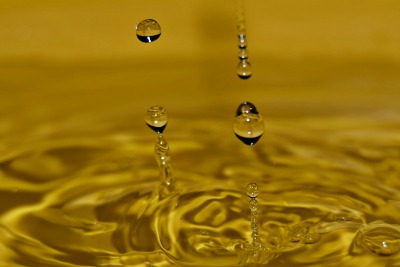6. Cohesion and Adhesion: Water molecules cling to each other and stick (adhere) to many surfaces.
The cohesive property of water is due to the hydrogen bonds which serve as a force of attraction between molecules to other molecules of water.
It is responsible for water’s continuous flow without breaking.
It is as if the hydrogen bond is a tying material that holds together a molecule and another molecule of water, preventing their separation.
The cohesion of water also accounts for the raindrops instead of mist, or the drops of water which fall from the margins of plant leaves early in the morning.
Where water drops get in contact with other drops without being subjected to considerable gravitational pull, they tend to be attracted and form a common cluster.
Water molecules likewise adhere to other polar and non-polar surfaces, a property called adhesion.
When water is splashed on a glass wall, a film of water attaches to the surface of the glass.
Similarly, when water is sprayed on the leaves of many plants, the surfaces of the leaves are wetted.
Thus water adheres to the inner surfaces of a glass tube and tends to climb upward.

The cohesion and adhesion properties of water, as well as its surface tension, make possible its vertical ascent in a narrow glass tube in an unbroken column of fluid.
This is called capillarity.
When under tension or pulled from the top, as when water on top escapes to the air due to evaporation (transpiration), the vertical ascent is even more pronounced.
Capillary movement, along with transpiration pull, helps explain how water reaches the tops of trees, even in old and tall coconut palms or in the California redwoods (Sequoia sempervirens), considered to be the tallest trees in the world.
But instead of tiny glass tubes, water moves through a system of interconnected tubelike tracheary elements of the xylem.
Likewise, through capillarity, water from the deeper parts of the soil can move upward between soil particles toward the root zone of plants.
REFERENCES
BETTELHEIM FA, MARCH J. 1998. Introduction to General, Organic & Biochemistry. 5th ed. Forth Worth: Saunders College Publishing. 809 p.
COHEN ER, LIDE DR, TRIGG GL (eds.). 2003. AIP Physics Desk Reference. 3rd ed. New York: AIP Press. p. 843.
DEVLIN R. 1975. Plant Physiology. New York, NY: D. Van Nostrand Company. 600 p.
MADER SS. 1993. Biology Part 1: The Cell. 4th ed. Duburque, IA, USA: Wm. C. Brown Communications, Inc. 152 p.
MATHEWS CK, VAN HOLDE KE. 1990. Biochemistry. Redwood City, CA: The Benjamin Cummings Publishing Company. 1129 p.
WALKER PMB (ed.). 1988. Cambridge Dictionary of Science and Technology. Cambridge: Cambridge University Press. 1008 p.
